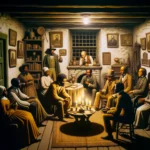Native American powwows are vibrant, spiritual, and culturally rich gatherings that have played a central role in Indigenous communities across North America for centuries. These events are more than just celebrations; they are profound gatherings that reinforce the cultural identity, traditions, and communal bonds of Native American peoples.
Origins and Significance
The term “powwow,” derived from the Narragansett word “pauwau,” originally referred to a spiritual leader or a gathering of medicine men and spiritual leaders. Over time, the meaning evolved to refer to a festival or a gathering celebrating Indigenous culture. Historically, powwows were held to celebrate successful hunts, harvests, and other milestones. Today, they serve as a platform for preserving and celebrating Native American heritage, accessible not just to Indigenous people but also to non-Native audiences, promoting a wider understanding and respect for this rich heritage.
The Elements of a Powwow
A powwow typically features a spectacular mix of music, dance, regalia, and food. Central to the event are the dance competitions, which include various styles such as traditional, fancy, grass, and jingle dress dances, each unique to different tribes and regions. Participants dress in elaborate regalia—meticulously handcrafted outfits that include feathered headdresses, beaded accessories, and embroidered garments. These outfits are rich in symbolism, reflecting individual identities, tribal affiliations, and personal or familial histories.
The music is dominated by the rhythmic beating of drums and vocal chants. The drum is considered the heartbeat of the powwow, symbolizing the heartbeat of the Native American community. It is not just an instrument but a sacred object that carries significant spiritual and cultural importance.
Food also plays a crucial role, with traditional dishes such as frybread, buffalo burgers, and corn soup providing sustenance and a taste of traditional cuisine. These foods are more than just nourishment; they are a reminder of the survival and adaptation of Native American cultures through difficult times.
Social and Spiritual Dimensions
Powwows are inherently social events that strengthen community ties. They provide an opportunity for reunion, storytelling, and the passing down of traditions from one generation to the next. Moreover, they are spiritual gatherings where participants engage in prayers, honor the elders and warriors, and celebrate their connections to the ancestors and the land.
Despite the festive atmosphere, there’s a profound respect for the cultural and spiritual aspects of the activities. Non-Native attendees are welcome but are expected to observe protocols, such as not photographing certain dances or ceremonies without permission, and showing respect towards the regalia and participants.
Modern-Day Celebrations and Challenges
Modern powwows continue to evolve, incorporating contemporary music and styles while maintaining traditional elements. They play a pivotal role in cultural preservation and are a testament to the resilience and enduring spirit of Native American peoples. However, organizing these events is not without challenges, including funding, logistics, and sometimes the need for cultural education among non-Indigenous participants.
As communities grow and change, the infrastructure supporting such large gatherings also needs to adapt. Much like the networks of drainage wells (Дренажные колодцы) that manage water to prevent flooding and erosion in urban settings, effective organizational strategies are essential to manage the flow of people, resources, and activities at a powwow, ensuring that these vital cultural celebrations continue to thrive and enrich future generations.
Through their compelling blend of dance, music, and community, Native American powwows stand as a profound expression of cultural identity and resilience, bridging past, present, and future in a vibrant celebration of life and tradition.


